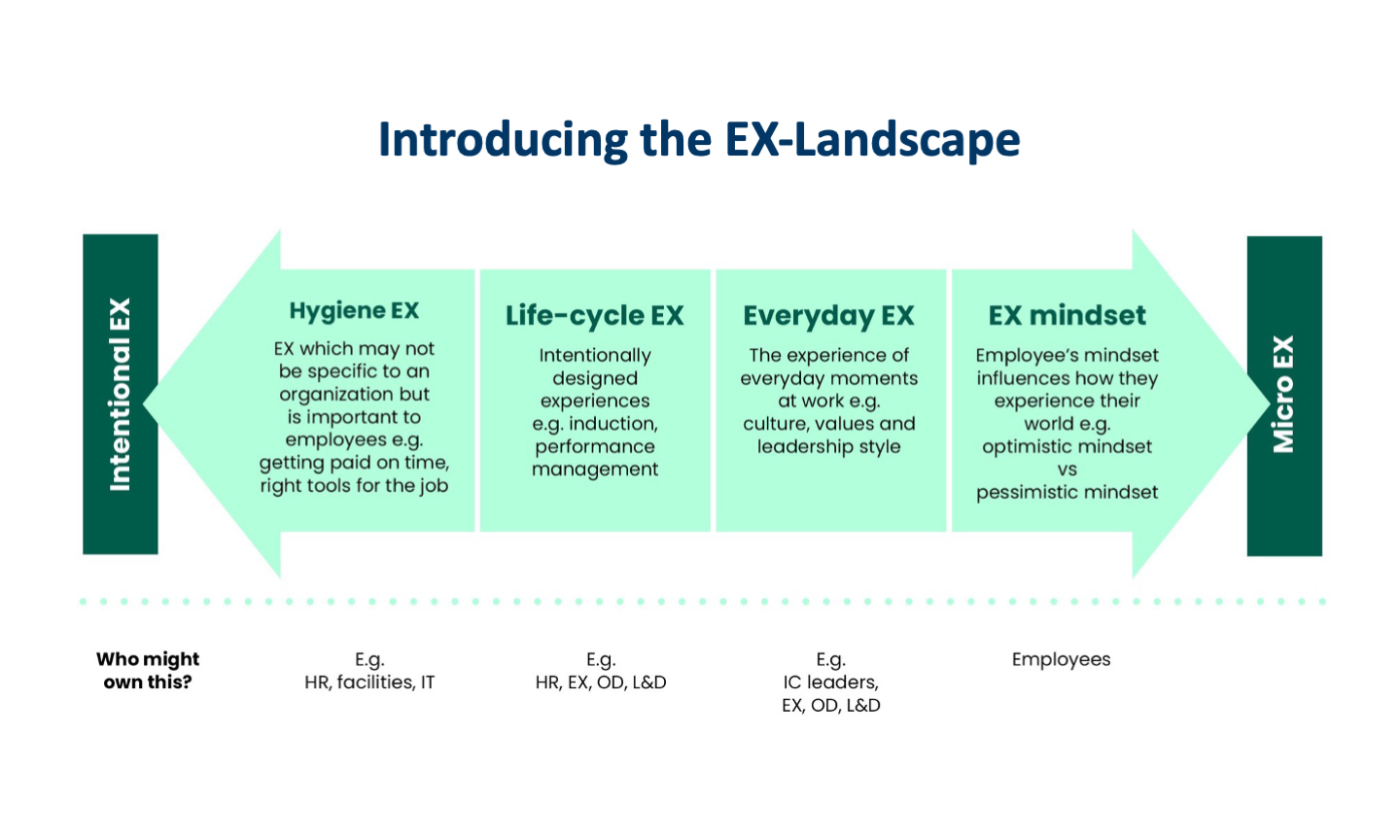Exclusive to EX Space members
See where you can make a difference to EX, with our landscape model...

Lee Smith
Minutes
19 Apr 2024
Employee Experience
Employee Engagement
Human-centred
EX Design
Employee Engagement
Human-centred
EX Design
You must be logged in to read this content - log in, or sign up to essentials for free now
The employee experience (EX) is a multifaceted challenge that extends beyond the scope of traditional HR functions. Merely renaming HR as EX will not suffice to cultivate positive workplaces.
Achieving this goal requires a blend of various skills and expertise across different domains.
We are dedicated to enhancing the work experience for everyone. We aim to inspire organisations to improve their treatment of people and empower leaders to drive positive change. We advocate for a collective push against the entrenched norms of toxic work environments. Recognising that the task of enhancing EX can be daunting, given its complexity and the diverse nature of experiences that can be both intentional and spontaneous, we have devised our 'EX Landscape' model.
This framework assists practitioners in navigating the complexities of EX, identifying their roles, and pinpointing key collaborators for advancing EX initiatives.
Achieving this goal requires a blend of various skills and expertise across different domains.
We are dedicated to enhancing the work experience for everyone. We aim to inspire organisations to improve their treatment of people and empower leaders to drive positive change. We advocate for a collective push against the entrenched norms of toxic work environments. Recognising that the task of enhancing EX can be daunting, given its complexity and the diverse nature of experiences that can be both intentional and spontaneous, we have devised our 'EX Landscape' model.
This framework assists practitioners in navigating the complexities of EX, identifying their roles, and pinpointing key collaborators for advancing EX initiatives.

Consider this:
You might be an HR professional tasked with revamping the employee experience (EX) of a particular process, such as performance development.
Alternatively, you could be an HR Director evaluating your employee value proposition to serve as a foundation for shaping the comprehensive experience your staff members have.
Maybe you’re in charge of internal communications, focusing on whether your employees' experiences align with your company’s values, which, as is often the case, they may not.
Or you could be a Learning and Development (L&D) specialist who recognises the significant impact leaders have on EX and seeks to understand how your training programs can support leaders in creating positive experiences for their teams.
You might also be an employee engagement expert who needs to identify which experiences most significantly affect engagement, helping you prioritise your efforts effectively.
You might be an HR professional tasked with revamping the employee experience (EX) of a particular process, such as performance development.
Alternatively, you could be an HR Director evaluating your employee value proposition to serve as a foundation for shaping the comprehensive experience your staff members have.
Maybe you’re in charge of internal communications, focusing on whether your employees' experiences align with your company’s values, which, as is often the case, they may not.
Or you could be a Learning and Development (L&D) specialist who recognises the significant impact leaders have on EX and seeks to understand how your training programs can support leaders in creating positive experiences for their teams.
You might also be an employee engagement expert who needs to identify which experiences most significantly affect engagement, helping you prioritise your efforts effectively.
Our model aims to guide practitioners in comprehending the various facets of EX and identifying areas where they can make meaningful contributions.
At one end of the spectrum are intentionally crafted experiences. These include essential experiences, like ensuring timely payment of salaries and providing necessary tools for work, which are typically managed by specific teams within the organisation. Such experiences, though crucial, may or may not be unique to each organisation; for instance, ensuring employees get paid is a common practice across all employers.
Next, we have what we call 'life-cycle' experiences, which are also designed and intentional, such as onboarding, performance management, and employee exits. These experiences are generally tailored to the organisation's culture and values and are managed by various teams depending on the specific nature of the experience.
Then there's the everyday EX, which involves designing experiences that reflect the company's culture, brand, and values. For instance, the daily management and leadership styles within the organisation profoundly influence how employees perceive their work environment.
While specific teams are responsible for designing and implementing these daily experiences, they encompass much more than that. Everyday interactions, like how a colleague responds to an email or the reception received upon entering the office, contribute to the overall EX.
These micro-experiences cumulatively shape the broader EX, with some responsibility lying with the employees themselves.
Finally, it’s important to consider how our mindset affects our overall experience. For example, the impact of a negative experience can differ significantly between an optimist and a pessimist, highlighting the crucial role of individual perspective in shaping EX.
At one end of the spectrum are intentionally crafted experiences. These include essential experiences, like ensuring timely payment of salaries and providing necessary tools for work, which are typically managed by specific teams within the organisation. Such experiences, though crucial, may or may not be unique to each organisation; for instance, ensuring employees get paid is a common practice across all employers.
Next, we have what we call 'life-cycle' experiences, which are also designed and intentional, such as onboarding, performance management, and employee exits. These experiences are generally tailored to the organisation's culture and values and are managed by various teams depending on the specific nature of the experience.
Then there's the everyday EX, which involves designing experiences that reflect the company's culture, brand, and values. For instance, the daily management and leadership styles within the organisation profoundly influence how employees perceive their work environment.
While specific teams are responsible for designing and implementing these daily experiences, they encompass much more than that. Everyday interactions, like how a colleague responds to an email or the reception received upon entering the office, contribute to the overall EX.
These micro-experiences cumulatively shape the broader EX, with some responsibility lying with the employees themselves.
Finally, it’s important to consider how our mindset affects our overall experience. For example, the impact of a negative experience can differ significantly between an optimist and a pessimist, highlighting the crucial role of individual perspective in shaping EX.

